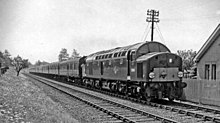British Rail Class 40
[citation needed] Despite their initial success, by the time the last examples were entering service they were already being replaced on some top-level duties by more powerful locomotives.
British Railways originally ordered ten Class 40s, then known as "English Electric Type 4s", as evaluation prototypes.
Sir Brian Robertson, then chairman of the British Transport Commission, was less than impressed, believing that the locomotives lacked the power to maintain heavy trains at high speed and were too expensive to run in multiple – opinions that were later proved to be correct.
Airing his views at the regional boards prompted others to break cover and it was agreed that later orders would be uprated to 2,500 hp (a change that was never applied).
Direct comparisons on the Great Eastern Main Line showed they offered little advantage over the "Britannia" class steam locomotives when driven well, and the Eastern Region declined to accept further machines as they deemed them unsuitable to replace the Pacific steam locomotives on the East Coast Main Line,[5] preferring to hold on until the "Deltic" Class 55 diesels were delivered.
The West Coast Main Line had been starved of investment for many years and the poor track and generally lower speeds (when compared to the East Coast route) suited Class 40s, as the need to hold trains at speed for long periods simply did not exist and it better took advantage of their fairly rapid acceleration.
[6] Batches of the class were built with significant design differences, due to changes in railway working practices.
Later, it was decided that locomotives should display the four character train reporting number (or headcode) of the service they were hauling, and Nos.
Another policy decision led to the discontinuing of the gangway doors (which enabled train crew to move between two or three locomotives in multiple).
The heyday of the class was in the early 1960s, when they hauled top-link expresses on the West Coast Main Line[16] and in East Anglia.
The train heating boilers were a particular early problem on the EE type 4's, requiring strict maintenance and were fairly complicated to operate.
In later life the locomotives were mainly to be found hauling heavy freight and passenger trains in the north of England and Scotland.
Throughout the early 1980s Class 40s were common performers on relief, day excursion (adex) and holidaymaker services along with deputisation duties for electric traction, especially on Sundays between Manchester and Birmingham.
Much rarer workings include visits to London's Paddington and Euston stations, Norwich, Cardiff and even Kyle of Lochalsh.
The fact that 40s could turn up almost anywhere resulted in them being followed by a hard core of bashers, enthusiasts dedicated to journeying over lines with rare traction for the route.
Also, many Class 40s were not fitted with air braking, leaving them unable to haul more modern freight and passenger vehicles.
These included the pioneer locomotive, 40 122, which, having been withdrawn in 1981, was reinstated in July 1983 and painted in the original green livery to haul rail enthusiasts' specials.
Upon the joint initiative of enthusiasts Howard Johnston and Murray Brown who noticed 40 122 on the withdrawn sidings at Carlisle Kingmoor depot in summer 1981 ready to go to Swindon Works for breaking up.
[3][citation needed] Following a three-year hiatus, after suffering a traction motor flashover, 40 145 returned to mainline operation in 2014.
Upon withdrawal the locomotive was offered to the National Railway Museum at York as an exhibit loco regarding its past history.
However, the NRM declined and it was scrapped at Doncaster Works with indecent haste, no doubt to stop any pillaging souvenir hunters.
[33] D212 Aureol was briefly sent to Vic Berry's scrapyard for asbestos removal, before being moved to its new home at the Midland Railway Centre.
In 2023, Bachmann released a new tooled Class 40, including D213 Andania, which is presented in her current Main Line operating condition; BR Green livery with small yellow panels.
[39] British N gauge models of the Class 40 have been produced by Graham Farish, representing the main three headcode versions.
A BR Green version of D211 Mauretania received a positive review from The Railway Magazine Guide to Modelling in 2017.








